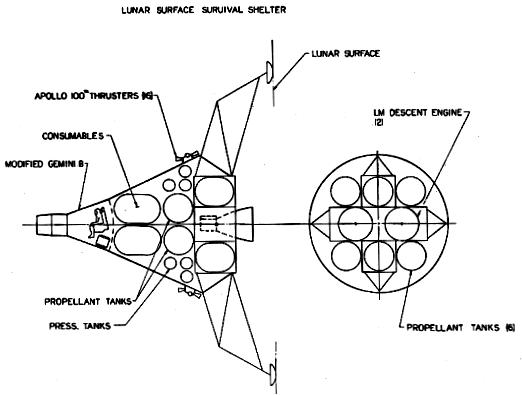
Home - Search - Browse - Alphabetic Index: 0- 1- 2- 3- 4- 5- 6- 7- 8- 9
A- B- C- D- E- F- G- H- I- J- K- L- M- N- O- P- Q- R- S- T- U- V- W- X- Y- Z
Gemini Lunar Surface Survival Shelter

Gemini Lunar SSS
Drawing of the Gemini Lunar Surface Survival Shelter. The shelter would be landed, unmanned, near the landing site of a stranded Apollo Lunar Module. In the event the LM ascent stage would not light to take the crew back to the Apollo CSM in lunar orbit, the two astronauts could go to the shelter and await a rescue mission. The astronaut in the CSM would return alone in the Apollo spacecraft.
Credit: McDonnell Douglas
Status: Study 1967. Thrust: 88.06 kN (19,797 lbf). Gross mass: 45,000 kg (99,000 lb). Unfuelled mass: 15,000 kg (33,000 lb). Specific impulse: 311 s.
In the event the LM ascent stage would not light to take the crew back to the Apollo CSM in lunar orbit, the two astronauts could go to the shelter and await a rescue mission. The astronaut in the CSM would return alone in the Apollo spacecraft.
In the wake of the Apollo fire, NASA reexamined many safety aspects of the Apollo project. The Apollo mission profile was inherently risky, and the likelihood of a crew being stranded in lunar orbit or on the lunar surface was relatively high. McDonnell returned to a concept first studied in 1962 - the use of Gemini as a Lunar Rescue Vehicle. Use of the Gemini B capsule, then in construction for use with the US Air Force's Manned Orbiting Laboratory, with various combinations of Apollo lunar module stations, would provide a rescue vehicle that could pick up Apollo astronauts stranded in lunar orbit or on the lunar surface. Three variant rescue schemes were studied, a Gemini Lunar Orbit Rescue Vehicle, a Gemini Lunar Surface Survival Shelter, and a Gemini Lunar Surface Rescue Spacecraft. McDonnell summarized the advantages of the various schemes, as contrasted with use of Apollo hardware for the same task, as follows:
- Lunar Orbit Rescue Gemini: Modified Gemini & repackaged LM Ascent Stage. Unmanned to lunar orbit, three man direct return. Advantages: Uses developed equipment. Disadvantages: New spacecraft development. Recommendation: Do not develop-rescue capability too limited. Greatest emergency potential at lunar surface.
- Lunar Orbit Rescue Apollo: Apollo CSM. Unmanned to lunar orbit, three man direct return. Advantages: No new development. Can be accomplished with current acquisitions. Disadvantages: Possibility of same failure mode. Recommendation: Do not develop-rescue capability too limited. Greatest emergency potential at lunar surface.
- Lunar Surface Survival Shelter Gemini: Vehicle Description: Modified Gemini & Modified LM Descent Stage. Mission: Unmanned to lunar surface, 28 day quiescent storage, 28 day 2-man operation. Advantages: Extension of lunar orbit vehicle. Disadvantages: New spacecraft development. Recommendation: Do not develop - need for shelter and total number of Saturn launches reduced by providing an on-station backup return capability.
- Lunar Surface Survival Shelter Apollo: Vehicle Description: Modified SM & Modified LM. Mission: Unmanned to lunar surface, 30 day manned operation. Advantages: Similar to planned post-Apollo exploration shelter. Disadvantages: Requires modifications to existing hardware. Recommendation: Do not develop - need for shelter and total number of Saturn launches reduced by providing an on-station backup return capability.
- Lunar Surface Rescue Gemini: Vehicle Description: Modified Gemini, repackaged LM Ascent Stage & Modified LM Descent Stages. Mission: Unmanned to lunar orbit, 30 day unmanned quiescent stay, 2 man direct return. Advantages: Extension of lunar orbit/shelter vehicle. No rendezvous required. Direct return. Disadvantages: New spacecraft development. Recommendation: Modify to a 'Universal' Rescue Vehicle by improving capability to cover three-man cases.
- Lunar Surface Rescue Apollo: Vehicle Description: Apollo CSM & LM. Mission: Unmanned to lunar orbit, LM to lunar surface, LM to lunar orbit, 2 man return. Advantages: No new development. Same as existing mission. Disadvantages: Rendezvous required. May be difficult to automate transpose docking. Recommendation: Modify to a 'Universal' Rescue Vehicle by improving capability to cover three-man cases.
This last attempt to resuscitate Lunar Gemini failed as well. At that point in the Apollo program cut-backs already had begun. No funds would be forthcoming to build additional launch vehicles and spacecraft beyond those already purchased. There was definitely no money to provide a rescue capability, using either Apollo or Gemini hardware.
Crew Size: 2. Habitable Volume: 3.00 m3. Spacecraft delta v: 3,400 m/s (11,100 ft/sec).
Family: Lunar Landers, Moon. People: McDonnell. Country: USA. Spacecraft: Gemini Lunar RM, Gemini LSSS LM, Gemini LSSS SM. Launch Vehicles: Saturn V. Propellants: N2O4/UDMH. Agency: NASA. Bibliography: 209.
Back to top of page
Home - Search - Browse - Alphabetic Index: 0- 1- 2- 3- 4- 5- 6- 7- 8- 9
A- B- C- D- E- F- G- H- I- J- K- L- M- N- O- P- Q- R- S- T- U- V- W- X- Y- Z
© 1997-2019 Mark Wade - Contact
© / Conditions for Use